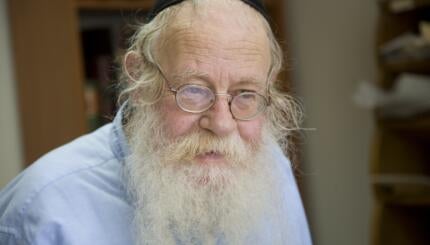Reprinted with permission from American Jewish Fiction: A JPS Guide (Jewish Publication Society).
For about their first 100 years of existence in the United States, comic books were regarded as simplistic, dumbed-down literature for the semiliterate–and the well-intentioned Classics Illustrated series founded by a Jewish entrepreneur named Albert Kantor, did not help to dispel that misperception.
The truth is that even a passing glance at a decent comic, or graphic novel, should inform the most skeptical reader that the genre requires about three times as much skill as writing a novel, which is difficult enough: to create a good comic, not only do you need to be able to write but also to draw and handle layout expertly. To create his masterful Jewish comics, Ben Katchor adds to all these skills a breathtaking sensitivity for Jewish culture and history and also what he has referred to as an “extensive background in book and print production.”
Nowhere is his virtuosity on display more than in his fantasia of the 1830s, The Jew of New York. The plot of this novel is impossible to describe, but here goes nothing: Nathan Kishon, a butcher, is discredited through a scandal involving treif beef tongue and becomes a follower of Mordecai Manuel Noah-a real historical figure who wanted to establish a sovereign Jewish colony in upstate New York.
After that falls through, Kishon meets a Jewish trapper, Ketzelbourd, who has been in the wild so long he has become animalistic and developed a bizarre sexual obsession. Among Kishon’s adventures with Ketzelbourd is a brief sojourn at an air-worshiping commune that uses Hebrew script and practices the theories of Joseph Priestly, who discovered oxygen. Back in New York, an anti-Semitic satiric play about Noah is being put on by the New World Theater, whose crew includes a Jewish set designer.
With your help, My Jewish Learning can provide endless opportunities for learning, connection and discovery.
The book’s climax, such as it is, takes place in the playhouse and involves Ketzelbourd attacking an actor, and an apparatus, designed to fill the theater with the aroma of pickled herring, burning the place down. But plot matters less than Katcher’s gallery of perplexing characters on the most bewildering of missions such as Yossl Feinbroyt, a kabbalistic-inclined scholar who transcribes, in English characters, the sounds people make while eating, and Francis Oriole, who plans to carbonate Lake Erie and pipe seltzer water to the masses.
Creating a fiction much stranger than truth, Katchor manages to evoke some critical themes from the weird old days of the early 19th century, including Noah’s hopes for a Jewish state in America and the widely held belief that Native Americans might have been one of the lost tribes of Israel. (Katchor’s cast includes an Indian, Elim-Min-Nopee, who has been trained to recite the Sabbath prayer Lekhah Dodi to dime-museum audiences.) Katcher’s textual flourishes include a series of impossible period-replica handbills, such as a Yiddish transliteration of the introduction to the Declaration of Independence and a poster advocating restraint when it comes to “the practice of Onanism in private houses.”
Not always comprehensible-thankfully the book is short, as rereading seems almost inevitable if a reader wants to piece together much of the plot Katcher’s panels are nonetheless always meticulously produced and evocative, in a way that seems somehow vividly Jewish, of a time and place that never really was.
Further reading
Katchor’s other strips, most of which have appeared in the Forward and in other newspapers, have been collected in the volumes Cheap Novelties (1991) and two others named for his famous character, Julius Knipl (1996 and 2000); his works have been translated into many languages, including French, Italian, and Japanese. Much of Katchor’s fame owes to a sympathetic profile in the New Yorker in 1993; he was awarded a MacArthur Fellowship in 2000, and maintains a website at http://www.katchor.com.
The list of worthwhile Jewish graphic novels of note has grown quickly and expands further every year. A few places to start would be Peter Kuper’s adaptations of Kafka in Give It Up! (1995) and The Metamorphosis (2003), James Sturm’s The Golem’s Mighty Swing (2001), J. T. Waldman’s Megillat Esther (2005), Harvey Pekar’s The Quitter (2005), Rutu Modan’s Exit Wounds (2007), and Joann Sfar’s The Rabbi’s Cat (2005) and Klezmer (2006). Also see The Jewish Graphic Novel (2008), an academic study of the field.


